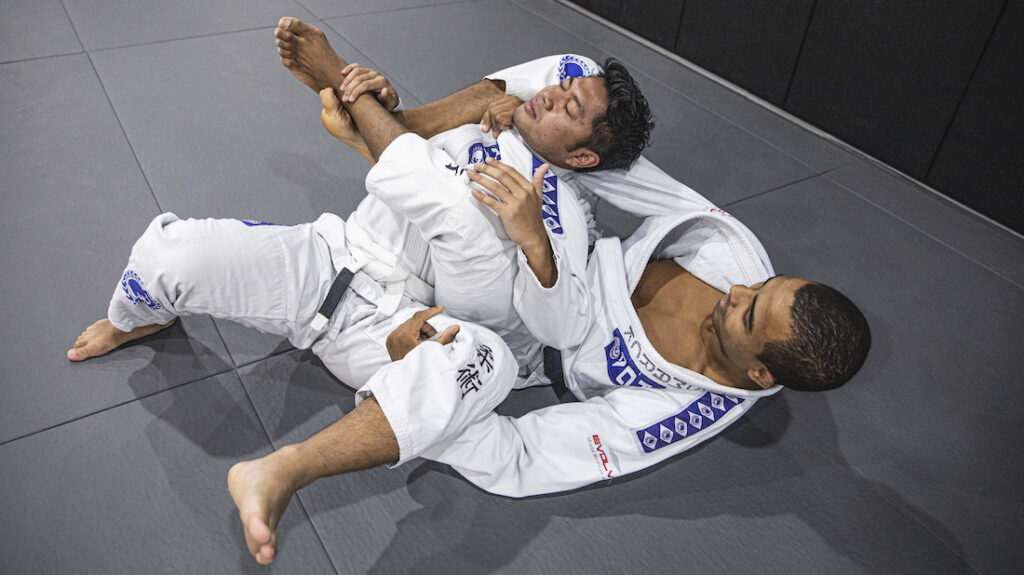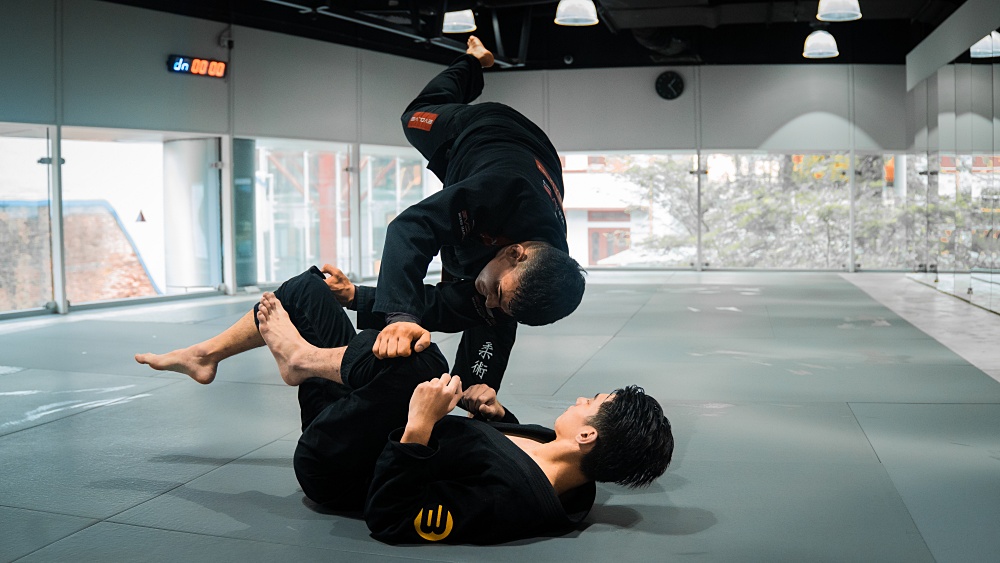One feature of Jiu-Jitsu with the gi is the accessibility of collar chokes. Collar chokes are powerful, and can be applied in almost any position. It can be performed on the full mount, side control, back mount, or even from the closed guard. This article will talk about one of the strongest BJJ chokes in the gi, the bow and arrow.
What Is The Bow And Arrow Choke In BJJ?
The bow and arrow, also known as the okuri-eri-jime (sliding collar strangle) in Judo, is one of the strongest chokes in BJJ. Proving its power and effectiveness in international competitions, the bow and arrow choke has one of the highest submission rates in BJJ tournaments.
It is performed by grabbing the opponent’s own collar from behind and using it to strangle him. The body moves to the side to gain a better angle and leverage, and the other hand preferably holds the opponent’s pants to prevent them from turning.
The bow and arrow choke works in the same fashion as the rear naked choke. Both submissions target the carotid artery in the neck to impede the blood flow to the brain, putting them to sleep. Similarly, the bow and arrow and the rear naked choke both work just as well against bigger and stronger opponents.
Applying The Bow And Arrow Choke
In the video, Roy Dean showed how to execute the bow and arrow choke. The bow and arrow choke is typically performed from the back mount. Initially, before any submissions, it is important to first secure the position. The key factor in maintaining the back mount is to apply chest to chest, and as the case may be, even with gi, a seatbelt.
After securing the back mount with a seatbelt, the opponent typically will try to break it. If the opponent pulls down the top hand of the seatbelt, an attempt for a rear naked choke is always present. That being said, the seatbelt is used to secure the position to pop the opponent’s collar up and start the collar grip with thumbs inside.
Practitioners often have a hard time successfully gripping the collar of the opponent, as the element of hand fighting also comes into place. Therefore, it is essential to give time practicing attacking from the back during training sessions. Subsequently, after successfully grabbing the collar, you may now grab the opponent’s pants near the knee area.
To effectively apply the bow and arrow choke, you must get used to turning your body 90 degrees from the back mount to have a better angle. Lastly, finish the choke by leaning backward to gain better leverage.
Bow And Arrow Choke From Half Guard
There are different ways to initiate the bow and arrow choke, although it always has the same ending with your body turned to the side and choking the opponent from behind.
BJJ World Champion Teco Shinzato from the Evolve Fight Team exhibited a sneaky bow and arrow choke from the top half guard in the video. Starting from the top half guard, Teco instructs to block both biceps of the opponent. He then posted his far hand on the floor under the top hand of the uke while changing his base. After changing base, he grabbed the gi and pants, while freeing his knee from the half guard to step over. Stepping over and gaining partial back control, Teco grabbed the uke’s collar from behind to apply the bow and arrow, and reached for the uke’s foot while crossing his feet to finish the choke.
Standing Bow And Arrow
The bow and arrow choke can also be set up from a standing position. This setup will require your confidence to execute correctly. In a standing bow and arrow, you must first get behind your opponent. In order to do that, you need to fake or shoot takedowns, or do an arm drag successfully.
Getting behind the opponent while standing is already a challenge. Once behind the opponent, start by securing the position with a body lock seatbelt grip. Next is to jump up behind the opponent as you apply the seatbelt. From there, you can now pop the collar of the opponent and apply the collar grip.
Proceed to the typical bow and arrow set up by turning your body to the side while grabbing the pants. Turning your body to the side as you apply the choke will cause the opponent to lose balance and roll over the floor, following your body weight.
No-Gi Bow And Arrow Choke
The bow and arrow can also be done in no-gi. Although, some details will be changed, such as the grips. In no-gi, there will be no collar and pants to hold on to. Instead, the grip on the collar will be changed to a grip on the wrist, and the grip on the pants will be to the legs instead.
Final Thoughts
The bow and arrow may look fancy and impractical to some, but it is one of the strongest chokes in BJJ. It can be initiated from different positions, which makes this choke appealing to work with. Given that it is one of the most potent ways to strangle an opponent, showing its powerful application in the gi, it can work wonders if done expertly. The bow and arrow choke is a great technique and can be applied in a self-defense grappling scenario, along with the rear naked choke.
You may also like:

















